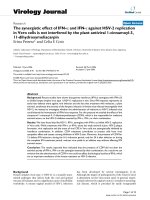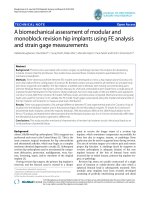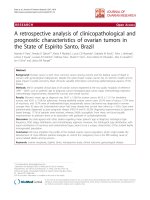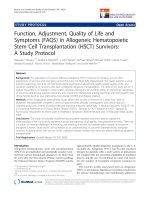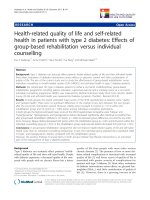Báo cáo hóa học: " Min Wu Department of Electrical and Computer Engineering" pot
Bạn đang xem bản rút gọn của tài liệu. Xem và tải ngay bản đầy đủ của tài liệu tại đây (603.45 KB, 4 trang )
EURASIP Journal on Applied Signal Processing 2004:14, 2077–2080
c
2004 Hindawi Publishing Corporation
Editorial
Min Wu
Department of Electrical and Computer Engineering, University of Maryland, College Park, MD 20742, USA
Email:
Nasir Memon
Department of Computer and Information Science, Polytechnic University, Brooklyn, NY 11201, USA
Email:
Touradj Ebrahimi
Signal Processing Institute, School of Engineering, Swiss Federal Institute of Technology (EPFL),
1015 Lausanne, Switzerland
Email: touradj.ebrahimi@epfl.ch
Ingemar J. Cox
Departments of Computer Science and Electronic and Electrical Engineering, University College London,
Adastral Park Postgraduate Campus, Ross Building, Martlesham Heath, Ipswish, Suffolk IP5 3RE, UK
Email:
New devices and software have made it possible for con-
sumers worldwide to create, manipulate, share, and enjoy
media more efficiently in digital forms. Internet and wireless
networks permit the delivery and exchange of multimedia in-
formation for such purposes as remote collaboration, distant
learning, and entertainment. A major concern of traditional
content owners is the ease with which perfect digital copies
can be created and distributed. These companies have argued
strongly for rights management technologies to assure that
content is delivered and used for its intended purpose and by
its intended recipients.
The successful development and adoption of media se-
curity and rights management technologies involve issues
within and beyond technolog y arena. The 1990s witnessed
a surge in interest in media security technologies, as evi-
denced from the huge rise of literature on multimedia se-
curity and rights management. Much of the industrial in-
terest was directed to the protection of movies and music.
The DVD format, the first high-quality digital video format
for consumers, was released in 1997 and the Copy Protec-
tion Technical Working Group (CPTWG) of the DVD Con-
sortium was responsible for investigating a variety of protec-
tion technologies to allay Hollywood’s concerns that such a
format would lead to widespread piracy similar to that be-
ing witnessed by the music industr y. Contemporaneously,
the music industry created the secure digital music initia-
tive (SDMI) to identify technologies to inhibit the copying
of music.
The SDMI is largely regarded as a failure while the
CPTWG’s efforts are somewhat mixed. The latter deployed
a variety of technologies including (i) a content-scrambling
system (CSS), (ii) Macrovision’s analog protection system
(APS), and (iii) a secure key exchange mechanism to per-
mit the transmission of digital content between compli-
ant devices. A fourth technology, digital watermarking, was
not adopted. The decision to deploy particular technolo-
gies was based on both technical merit and commercial a nd
political expedience. The latter manifests itself in the con-
flict of interests between content owners, consumer elec-
tronics (CE), and computer manufacturers. The content
owners are clearly the beneficiaries of antipiracy technol-
ogy. However, in most deployment scenarios, the cost of
these technologies is borne by the CE and computer indus-
try, who do not directly benefit from such technologies and
whose customers are not in favor of it. As a result, con-
sumers prefer to purchase equipment from manufacturers
who poorly implement security technologies and are there-
fore easy to circumvent. There is little commercial incen-
tive, except the threat of legal actions, for manufacturers to
develop secure devices, and Hollywood’s beneficiaries have
shown a strong reluctance to bear the cost of these technolo-
gies.
2078 EURASIP Journal on Applied Signal Processing
Hollywood’s attitude may be changing. This year (2004)
witnessed the widespread reporting of the fact that Hol-
lywood had identified the source of pirated material to a
video provided as a “screener” to one of the members of
the Academy of Motion Picture Arts and Sciences. Screen-
ers are copies of movies that are provided to the voters of
the Oscars. In this case, each screener had a unique iden-
tifier embedded in it, using digital watermarking technol-
ogy.
The ultimate success of digital rights management re-
quires a delicate balance between technology, business, and
the law. We note that several standardization consor tia, no-
tably the MPEG standard group, the Digital Media Project
(DMP), and the Secure JPEG 2000 (JPSEC), are actively
pushing forward standards to support the interoperability of
media security and r ights management systems.
The objective of this special issue is to bring together re-
cent advances in research, development, and standardization
of multimedia security and rights management to meet the
technical challenge. It is not surprising to see that signal pro-
cessing plays a key role in addressing the unique characteris-
tics of multimedia signals in contrast to generic data. In the
meantime, providing security and protection to multimedia
often requires combining signal processing theory, cryptol-
ogy, coding theory, communication theory, information the-
ory, and psychophysiology theory in human visual/auditory
perception. A signal processing focus coupled with the inter-
disciplinary flavor is reflected by the twelve papers collected
in this special issue.
The first six papers address issues on robust data embed-
ding, which provides an important building block for mul-
timedia rights management. A major advantage of data em-
bedding is its capability of associating some additional data
with the digital multimedia content in such a seamless way
that few conventional protection tools for generic digital data
such as cryptographic encryption can achie ve.
The paper “Facilitating watermark insertion by prepro-
cessing media” by Cox and Miller focuses on a complexity-
constrained scenario rising from real-world rights manage-
ment applications. More specifically, the embedding of wa-
termarks to multimedia content must be accomplished with
very limited computational power, while there is a consider-
able amount of freedom to determine and adjust the mul-
timedia signals feeding into the embedder. The paper pro-
poses and analyzes preprocessing techniques to enhance the
robustness of embedded watermarks.
Given that a proper choice of filter b ank can significantly
influence the perceptual quality and robustness of wavelet-
domain watermarking, the paper “Filters ranking for DWT-
domain robust digital watermarking” by Dietze and Jassim
aims at studying the relationship between various embed-
ding parameters/strategies and the performance ranking of
different wavelet filters. The study suggests that the sub-
bands chosen for embedding, the embedding method, and
the types of compression attacks are the influential factors.
Consequently, the optimal filters under several embedding
and attack combinations are identified in the paper.
In “Linear and nonlinear oblivious data hiding,” Gang et
al. study the oblivious/blind watermarking techniques that
can reliably extract hidden information without reference to
the original unmarked signal. The paper first examines per-
formance and identifies limitations of the linear techniques
based on direct-sequence modulation. An improved non-
linear technique is then proposed based on set partition-
ing.
The paper “RST-resilient video watermarking using
scene-based feature extraction” by Jung et al. proposes a set
of DFT-based spatial-temporal features as watermarking do-
main and employs constrained optimization techniques to
embed desired watermark in the chosen features. The exper-
iments demonstrate that the proposed watermark can resist
compression, spatial geometric distortions, and temporal at-
tacks.
Recognizing that the bit rate changes after watermark-
ing can trigger buffer overflow or underflow during the
video streaming, the paper “Improved bit rate control for
real-time MPEG watermarking” by Pranata et al. proposes
a compressed-domain watermarking technique for MPEG
video. The proposed technique explicitly performs rate con-
trol and can maintain a targeted bit rate for the watermarked
video.
The paper “Watermarking algorithms for 3D NURBS
graphic data” by J. J. Lee et al. addresses the protection
for 3D graphic data represented in nonuniform rational B-
splines. By working with a few virtual images based on
parametric sampling of a 3D graphic model, the new 3D
watermarking algorithm can take advantage of the exist-
ing techniques for images. The experimental results show
that the new algorithm is robust to various attacks and
reparameterization. The authors also propose a steganogra-
phy algorithm based on a similar idea of marking 2D fea-
tures and demonstrate advantages over the conventional ap-
proaches.
The next three papers build forensic capability upon
multimedia data embedding, providing digital domain evi-
dence for traitor tracing and authentication in multimedia
content management.
“Group-oriented fingerprinting for multimedia foren-
sics” by Wang et al. embeds unique fingerprint signals in
multimedia content to trace individual copies and deter in-
formation leak out of an authorized group of users. To
combat multiple-user collusion attacks, the authors propose
a hierarchical group-oriented construction of fingerprints,
which takes advantage of the prior knowledge of social, cul-
tural, and geographic ties between attackers and provides im-
proved resilience against collusion.
The paper “Image content authentication using pinned
sine transform” by Ho et al. proposes the use of pinned sine
transform to decompose an image into two mutually uncor-
related fields. As one of the fields, known as the pinned field,
contains the texture information, the authors embed the au-
thentication watermark into this field to signal texture alter-
ation while permitting a controlled amount of nontexture
content-preserving changes.
Editorial 2079
In “A secure and robust object-based video authentica-
tion system,” He et al. design an object-based authentica-
tion system capable of detecting malicious object tamper-
ing and in the meantime tolerating a number of content-
preserving operations. The paper employs a region-based
shape descriptor as the feature to which error correction cod-
ing and cryptographic hashing are applied to generate a ro-
bust authentication hash. The hash is then embedded in a
semi-fragile manner into objects in the video and used for
secure authentication.
The final three papers bring a system perspective to mul-
timedia security and rights management, focusing on the in-
tegration of multiple protection mechanisms and system ar-
chitectures.
In “MPEG-4 IPMP extension for interoperable protec-
tion of multimedia content,” Ji et al. present a recent MPEG
standardization effort on multimedia intellectual property
management and protection with a focus on the interoper-
ability. The paper provides an overview of the architecture,
the protection signaling, and the secure messaging frame-
work of MPEG-4 IPMP extension, as well as sample usage
scenarios.
The paper “Secure multimedia authoring with dis-
honest collaborators” by Sheppard et al. concerns the
content protection in a collaborative authoring scenario,
where multiple users contribute to the content creation.
The authors analyze the weaknesses of standard proof-of-
ownership watermarking approaches against dishonest in-
siders, and propose several possible system architectures em-
ploying watermarks and fingerprints to overcome the weak-
nesses.
In “Video waterscrambling: Towards a video protec-
tion scheme based on the disturbance of motion vectors,”
Bodo et al. design a content protection mechanism for
video that combines the functionality of watermarking and
selective encryption. The proposed waterscrambling tech-
nique encrypts the motion vectors in the compressed do-
main such that an unauthorized user only sees a quality
degraded video, and in the meantime allows the embed-
ding of an invisible watermark for post-decryption protec-
tion.
Overall, these twelve papers provide a wide spect rum of
technologies from academic and industrial contributors on
multimedia security and rights management. We thank the
authors, the reviewers, the Editor-in-Chief, and the publisher
for their tremendous effort made to this special issue. We
hope you, the readers, will enjoy the reading and find the
results in this issue beneficial in understanding and build-
ing security and rights management systems for multime-
dia.
Min Wu
Nasir Memon
Touradj Ebrahimi
Ingemar Cox
Min Wu received the B.E. degree in electri-
cal engineering and the B.A. degree in eco-
nomics from Tsinghua University, Beijing,
China, in 1996 (both with the highest hon-
ors),andtheM.A.degreeandPh.D.de-
gree in electrical engineering from Prince-
ton University in 1998 and 2001, respec-
tively. She was with NEC Research Institute
and Signafy Inc. in 1998, and with Pana-
sonic Information and Networking Labora-
tories in 1999. Since 2001, she has been an Assistant Professor in
the Department of Electrical and Computer Engineering, the In-
stitute of Advanced Computer Studies, and the Institute of Sys-
tems Research at the University of Maryland, College Par k. Dr. Wu’s
research interests include information security, multimedia signal
processing, and multimedia communications. She received a CA-
REER Award from the US National Science Foundation in 2002,
a George Corcoran Faculty Award from University of Maryland in
2003, and a TR100 Young Innovator Award from the MIT Technol-
ogy Review Magazine in 2004. She coauthored a book, Multimedia
Data Hiding (Springer-Verlag, 2003), and holds four US patents on
multimedia secur ity.
Nasir Memon is a Professor in the Com-
puter Science Depar tment at Polytechnic
University, New York. He received his B.E.
degree in chemical engineering and M.S.
degree in mathematics from the Birla In-
stitute of Technology, Pilani, India, and re-
ceived his M.S. and Ph.D. degrees from
the University of Nebraska, in Computer
Science. His research interests include data
compression, computer and network secu-
rity, multimedia data security, and multimedia communications.
He has published more than 150 articles in journals and conference
proceedings. He was an Associate Editor for IEEE Transactions on
Image Processing from 1999 to 2002 and is currently an Associate
Editor for the ACM Multimedia Systems Journal and the Journal of
Electronic Imaging.
Touradj Ebrahimi received his M.S. and
Ph.D., both in electrical engineering, from
the Swiss Federal Institute of Technology
(EPFL), Lausanne, Switzerland, in 1989 and
1992, respectively. In 1993, he was a Re-
search Engineer at the Corporate Research
Laboratories of Sony. In 1994, he served as a
Research Consultant at AT&T Bell Labs. He
is currently a Professor at EPFL, where, be-
sides teaching, he is involved in research on
multimedia signal processing. He has been the recipient of various
distinctions such as the IEEE and Swiss national ASE award, the
SNF-PROFILE grant for advanced researchers, two ISO-Certif-
icates for key contributions to MPEG-4 and JPEG 2000, and the
Best Paper Award of IEEE Transactions on Consumer Electronics.
He became a Fellow of International Society for Optical Engineer-
ing (SPIE) in 2003 for outstanding contri butions in the field of vi-
sual information processing and coding. In 2002, he founded Emi-
tall SA, an R&D and consulting company i n the area of electronic
media innovations. His research interests include still, moving, and
3D image processing and coding, visual information security, new
media, and human computer interfaces. He is author and coauthor
of more than 100 research publications, and holds 10 patents.
2080 EURASIP Journal on Applied Signal Processing
Ingemar J. Cox received his B.S. degree
from University College London and Ph.D.
degree from Oxford University. He has
worked for AT&T Bell Labs and NEC Re-
search Institute and is currently Profes-
sor and Chair of Telecommunications in
the Departments of Electronic Engineering
and Computer Science at University College
London. He has worked on problems to do
with stereo and motion correspondence and
multimedia issues of image database retrieval and watermarking.
In 1999, he was awarded the IEEE Signal Processing Society Best
Paper Award (image and multidimensional signal processing area)
for a paper he coauthored on watermarking. From 1997 till 1999,
he served as Chief Technical Officer of Signafy Inc., a subsidiary of
NEC responsible for the commercialization of watermarking. Be-
tween 1996 and 1999, he led the design of NEC’s watermarking
proposal for DVD video disks. He is the coauthor of the book, Dig-
ital Watermarking, published by Morgan Kaufmann.



